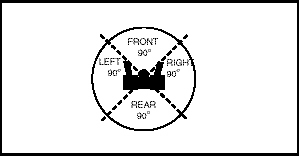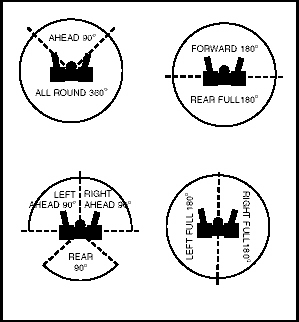Use the rules in the Epic 40,000 rulebook to determine who has the initiative and then take it in turns to pick a Titan and shoot with it. Titans which are in close combat with other Titans cannot fire ranged weapons. Titans which are in close combat with other Titans cannot be targeted by ranged attacks. Each ranged weapon on a Titan can be fired at a single enemy Titan, as long as it is within its fire arc and line of fire (see below). Different weapons can be, and often will have to be, directed against different targets. Note, however, that weapons with a RoF of 2 or more must still direct all their shots at a single target, they cannot split their fire. Each weapon mount on a Titan determines the direction a weapon can be pointed. Obviously, a weapon on one side of a Titan cannot swivel around to shoot over the opposite side, for example. This is called a weapon's 'fire arc' and only enemy Titans within the weapon's fire arc can be targeted. There are several different fire arcs as listed below and all fire arcs are worked out from the centre of the Titan model:
The weapon can fire in a 90° arc in front of the Titan. The weapon can be fired in a 180° arc to the front of the Titan The weapon can fire in a 90° arc from straight ahead to a right angle to the appropriate side. The weapon can fire in 180° arc from straight ahead to directly behind.  REAR
(R) REAR
(R) The weapon can fire in a 90° arc directly behind the Titan. The weapon can fire in a 180° arc to the rear of the Titan. As well as being able to physically turn towards a target, a weapon must be able to see it! This is called having a 'line of sight'. If a Titan does not have a line of sight (LOS) to an enemy, then it cannot fire at it! Line of sight is fairly simple to work out – draw an imaginary line from the weapon mount to the target. If there's anything blocking this line, then the target cannot be seen! Most of the time it will be obvious if a target can be seen, though sometimes it'll be necessary to get down and have a 'model's eye' view to see if it has a line of sight. If you can see only a small part of the enemy, such as the tip of a flag pole or weapon, or a foot poking around a building, then this isn't really enough for a line of sight. If you can see up to about half of the target then this has line of sight, but the target will be harder to hit (see Cover below) and if you can see more than half of the target then you've got a clear shot. Once you have established which enemies are in line of sight an fire arc for each of your Titan's weapons, you must declare which weapons are firing at which targets. You cannot fire one weapon and see how it does before firing the next - you must declare your targets before you start rolling any dice. You must also announce whether you are firing high or low, as this influences which locations may be hit on the target Titan. If a Titan’s legs are hidden by cover, then you may not aim low. Similarly, if all you can see are a Titan’s legs (unlikely but not beyond the realms of possibility) then you must aim high. Although you must declare your targets for the Titan first, you can resolve the firing of the Titan’s weapons in whichever order you wish (using more rapid fire weapons to deplete void shields before firing your ‘killing blow’, for instance). To hit its target, a weapon must obviously be in range. Measure the distance from the firing Titan to the target. Rather than go into a complex rules essay here about where to measure ranges are from, different solutions for measuring ranges are provided in the designer’s notes later on. If the target Titan is within the Range of the weapon then the target may be hit, if the target is further away than the weapon's Range then the shot automatically misses. For each point of Rate of Fire the weapon has, roll 1D6. Each dice roll that scores equal to or more than the Gunnery value of the Titan has hit the target. However, the dice roll you need to get may be changed by the following factors: If the target has not yet moved this turn, add +1 to rolls to hit. If the firing Titan has not yet moved this turn, add +1 to rolls to hit. If the target has moved 20cm or greater this turn, deduct 1 from your to hit rolls. If at least half the target is out of line of sight, subtract 1 from your rolls to hit. If the target has a Man of 3 or more, deduct 1 from all to hit rolls. Add or subtract the weapon's Accuracy from each dice roll. A Titan with a Gunnery value of 4+ is firing its Gatling Blaster at an enemy Titan. A Gatling Blaster has RoF 4 and so the player rolls 4 dice, scoring a 3, 4, 5 and another 5. A Gatling Blaster has no accuracy modifier, but the target is behind a building and so counts as in cover. This deducts 1 from each of the to hit rolls, so that they count as 2, 3 and two 4's. This means that two of the shots have hit the target. Any dice roll which scores a natural 1 always fails, regardless of modifiers. Any dice roll which scores a natural 6 always succeeds, regardless of modifiers. When a Titan is hit, you must determine where the shot or blow has landed. For each hit, roll a D6 and compare it to the appropriate hit location table, depending on where the shot originated from. If the shot is directed high add +1 to the location roll, if it is fired low deduct 1 from the location roll. This gives the location hit and it's Armour value. Roll a D6 and add the weapon's strength to the roll. Deduct the location's armour value and look up the result on the chart below.
VOID SHIELD GENERATORS
WEAPON
LEGS
HEAD
PLASMA REACTOR
Titans of the Imperium are protected by energy fields called void shields. Each void shield can absorb a certain amount of damage before it's generator overloads and the void shield shuts down. Most Titans have several void shield generators and they must each be knocked down before the Titan suffers any damage. If the target has operational void shields any hits must be resolved against them rather than against the Titan itself, regardless of the direction from which the attack originated. Void shields have an Armour value of 8 and if the attack would inflict damage (i.e. is Strength 1 or more after deductions) the void shield has been burnt out and no longer has any effect until repaired (seeRepairs section). Each hit is worked out individually, so it is possible to knock out several void shields at once, or even knock down void shields with some hits and inflict damage with others. A Titan with 2 operational void shields is hit six times. 2 hits fail to knock down void shields, another two each knock down a void shield each, which means the last two hits are resolved against the Titan itself. |

 The
weapon has a 360° fire arc.
The
weapon has a 360° fire arc.